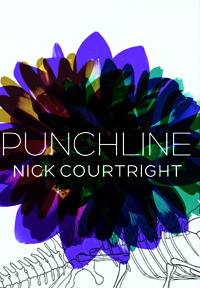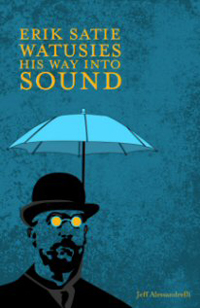 Tall, Slim & Erect: Portraits of the Presidents
Tall, Slim & Erect: Portraits of the Presidents
by Alex Forman
Les Figues Press, 2012
131 pages / $15 Buy from Les Figues Press
James Monroe was the third president to die on the fourth of July. Franklin Pierce was arrested for running a woman over with his horse. James Buchanan carried his head cocked to the side like a poll parrot (whatever that is). These and other trivial-pursuit answers are drawn from Tall, Slim & Erect: Portraits of the Presidents, Alex Forman’s compelling and often very funny book of short presidential biographies. With text appropriated from dozens of sources, Forman presents us with a surprisingly dishy view of our first thirty-seven leaders that, through her light touch, still manages to bring up some highly relevant questions about our expectations of history and our chaotic construction of public figures.
In his introduction to the text, Ben Ehrenreich characterized Forman’s effort as one to humanize the presidents, and the portraits are, indeed, deeply human, with a heavy emphasis on personal foibles and physical oddities. The Presidential body is essential to these portraits. Of course we might claim that the presidential body is essential to a great deal of political discourse—from Obama’s smoking and Cheney’s beat-less heart to that final dictatorial accessory, the glass coffin—but what Forman gives us is something different, not the body as symbol or the body as tool of power, but the body as body. Grant “had unusually small hands and feet,” Coolidge was “deficient in red corpuscles,” and while Washington’s famed wooden teeth don’t make an appearance, his pockmarks and bouts of dysentery do. The bodies depicted here are intimate bodies, embarrassingly physical, and not fit for public perusal—which makes it especially striking that this book is, in large part, a compilation of public perusals. Drawn from a few centuries worth of news, diaries, histories, speculations, Wikipedia articles, and gossip, Tall, Slim, & Erect is a distillation of the public gaze.
READ MORE >
1 Comment
April 27th, 2012 / 12:00 pm
 None of This Is Real
None of This Is Real
by Miranda Mellis
Sidebrow, April, 2012
115 pages / $18 Buy from Sidebrow or SPD
O, the subject of the title story of Miranda Mellis’s collection of short and long fiction, None of This Is Real, seeks solace (he has headaches—better to say “pain management,” then? we’ll see) in something called “Path to a Position™,” purveyed by its shadowy practitioner, Tiara Scuro: “She outlined for O the steps by which he would, with her, find his position. . . The old school believed the antidote for despair was courage, she said, but the real anti to the dote is a comforting distortion; this is what I call somatic realism.” “Somatic” realism? Is there another kind? Or do we deal in phenomenology?
“For years I had been removing the ground from under my clients,” she tells him,
But then I realized that what people really want is exactly what I was trying to subtract: a position, a Patch of Stability, a bit of personal ground in a time when actual ground is inaccessible for a variety of economic and environmental reasons, and in a time when positions, in the sense of steady employment, are scarce.
READ MORE >
Comments Off on None of This Is Real
April 23rd, 2012 / 12:00 pm
 (!x==[33]) Book 1 Volume 1
(!x==[33]) Book 1 Volume 1
by .UNFO
Blanc Press, 2011
776 pages / $50 Buy from Blanc Press
To be clear: (!x==[33]) Book 1 Volume 1 is a reformatting of Adolph Hitler’s Mein Kampf. The book itself, a conceptual work by .UNFO (a collaboration between Dan Richert and Harold Abramowitz) published by Blanc Press, acknowledges its source only obliquely. The publisher’s website simply tells us that this series “seeks to indexically lengthen the world’s most monumental texts through failed software operations”—that is, by filtering existing texts through the eponymous formula, redistributing chapters and paragraphs into chunks of approximately 33 syllables (rounded to the nearest whole word). On the book’s title page we find an innocuous url for a “0200601.txt” containing a (different) English translation of Mein Kampf archived by Project Gutenberg Australia. Indeed, the source text is apparent enough. We read the signature that follows the author’s forward, the table of contents, the recurring page header: MEIN KAMPF. It seems evasive, even disingenuous, certainly loaded, to characterize this project in such detached terms as a conceptual exercise, a “failed software operation”—the predictable imperfection, somehow poetic, of a system applied to lived reality. This instrumentalization maintains the willfully problematic stance that words are just words—stuff, material, to be shoveled around at will.
READ MORE >
6 Comments
April 16th, 2012 / 12:00 pm
 Threats
Threats
by Amelia Gray
FSG Originals, February 2012
288 pages / $14 Buy from Amazon
You’re in someone else’s body but you’re not really in someone else’s body, you’re in your own body, lying next to someone else’s body. “An embarrassment of childhood odor” – is it coming from your body? – steams around you, and you may or may not be wearing a fireman’s suit. This is what it feels like when Franny dies.
Franny: a large woman who wears five layers of lipstick and “smells like stones.” Franny: your wife. How she died, although you were there with her when she did, remains a mystery, even to you. A mystery: this is what it feels like to live.
This is also what it feels like to read Amelia Gray’s debut novel, Threats, out from Farrar, Straus and Giroux last month. To read it is to succumb to the emotional torpor and physical disorientation that is life after the death of a loved one. This means: a fair amount of hallucination, an undertone of deep sadness, intermittent boredom, and shots of curious paranoia. This means: laughing out loud and worrying that you shouldn’t be laughing because, hello, someone died and life is sad. This means: being as confused as David (our numb hero) is when he receives the “threats” the book is named for, finding a terrifying note in the crack behind the mirror, not worrying about what it means, or else worrying a lot, wondering who the hell has left it for you, who might be out to get you, and if Franny might be – tragically, for that would mean she’s left you – still alive.
READ MORE >
Comments Off on Composing the Decomposed: A Review of Amelia Gray’s Threats
April 13th, 2012 / 12:00 pm
 Punchline
Punchline
by Nick Courtright
Gold Wake Press, April 2012
96 pages / $12.95 Buy at Amazon or Powells
The title of Nick Courtright’s full-length debut suggests a book of jokes. However, the well-wrought poems in Punchline undermine these expectations. The joke is actually on all of us, the poet included. In Punchline, Courtight peers beneath the surface of the joke of existence, to see if he can better understand the comedian, the joke-writer, or the Grand Master of Ceremonies, if any of these exist.
Courtright’s revelatory odes to the mysteries of philosophy and science come right out of the visionary tradition, though they are filled with enough irony and self-doubt to avoid soapbox crankery (not that there’s anything wrong with that). In fact, it is Courtright’s embrace of the principles of uncertainty that give these poems life and beg us to re-read them, in order to be interrogated by them again and again. Courtright has the cold, hard stare of the soothsayer; it just so happens that everything in his world appears to be out of focus.
READ MORE >
2 Comments
April 9th, 2012 / 12:00 pm
 Erik Satie Watusies His Way Into Sound
Erik Satie Watusies His Way Into Sound
by Jeff Alessandrelli
Ravenna Press, 2011
66 pages / $11.95 Buy from Ravenna Press
One of the first things readers of Jeff Alessandrelli’s Erik Satie Watusies His Way Into Sound will notice is the fact that the back cover contains biographical material for both the author and Erik Satie; upon opening the book, the front matter contains acknowledgments from both men as well. The collection’s copy and front matter signal, it would seem, a playful engagement with identity and proper nouns. Specifically, Alessandrelli conflates himself, the speaker of his poems, and Erik Satie in such a manner that all three personalities become intimately entwined. The book’s first iteration of the list poem “A Game of Numbers” twice addresses this melding:
1. As we grow older our only investigation:
ever year searching for a sleeker, more
impulsive version of ourselves. (5)
…
8. As an adult Eric Satie became Erik Satie
to highlight his Scandinavian lineage.
Or on a whim. (6)
READ MORE >
Comments Off on Erik Satie Watusies His Way Into Sound
April 6th, 2012 / 12:00 pm
 Drive Me Out of My Mind: 24 Houses in 10 Years
Drive Me Out of My Mind: 24 Houses in 10 Years
by Chad Faries
Emergency Press, 2011
280 pages / $16 Buy from Amazon
In his 1958 book, The Poetics of Space, Gaston Bachelard writes, “if we want to go beyond history, or even, while remaining in history, detain from our own history the always too contingent history of the persons who have encumbered it, we realize that the calendars of our lives can only be established in its imagery.” The Poetics of Space describes a philosophy of poetic Imagism (precision of imagination) coupled with, in part, a phenomenology of the home as (not just) mortar, 2×4, and stone. In my reading of Bachelard, our histories are only as real as the Images that embody them.
I was reminded of The Poetics of Space when I read Chad Faries’ memoir, Drive Me Out of My Mind: 24 Houses in 10 Years. The book is separated into a chapter-per-house-lived-in, each chapter begins with a street-and-town, a year, and some song lyrics—a soundtrack to the book that almost acts as white noise on which we can focus when the screaming and partying in the foreground get too depressing. Each chapter ends with “and then we moved.” The book begins at Faries’ birth in 1971 and moves its readers through a difficult–sometimes funny, sometimes grotesque–landscape of pick-up-and-go with his drug-booze-and-sex addicted mother, her family of women, and a wild cast of male characters, to 1981. Drive Me is not only scaffolded by the houses the author lived in before he hit puberty, but Faries’ houses exist in a space created by the coupling of memory and imagination in order to forge the memoired homestead. “Our whole house,” Faries writes early on, “was made of the shadows of others, and we sucked that gray light into our guts to push the total darkness away and claim everything as our own.”
READ MORE >
2 Comments
April 4th, 2012 / 12:00 pm
 Unknown Arts
Unknown Arts
by William Walsh
Keyhole Press, 2012
142 pages / $9.99 Buy from Keyhole Press or Amazon
Unknown Arts by William Walsh (Keyhole Press, 2012) is a collection of critical appropriations sourced from James Joyce’s Ulysses, Finnegan’s Wake, A Portrait of the Artist as a Young Man, Dubliners, and more. A book about Joyce’s books, Unknown Arts can be read as analysis, distortion, homage, and/or a work of art all of its own. It is doubtless a contentious book that will likely add fuel to the ongoing and often fiery debates around contemporary criticism, the imprint of influence, and the nature of creativity. Controversial or not, the collection is a valuable artifact that allows rare access into what are for many the impenetrable works of a literary master.
Here’s an excerpt from one of the many texts in the collection appropriated from Ulysses (1922), titled “Sunny Jim 2”:
Near the end, remembering king David and the Sunamite, he shared his bed with Athos, faithful after death. But thou hast suckled me with a bitter milk: my moon and my sun thou hast quenched for ever. There’s the sun again coming out. Paris rawly waking, crude sunlight on her lemon streets. Under its leaf he watched through peacocktwittering lashes the southing sun. The coroner’s sunlit ears, big and hairy. A flying sunny smile rayed in his loose features. His eyeglass flashed frowning in the sun. The tip of his little finger blotted out the sun’s disk. Mercy of God the sun was in his eyes or he’d have left him for dead. WAS JESUS A SUN MYTH? By heaven, I am guiltless as the unsunned snow! It What went forth to the ends of the world to traverse not itself, God, the sun, Shakespeare, a commercial traveller, having itself traversed in reality itself becomes that self.
READ MORE >
2 Comments
April 2nd, 2012 / 12:00 pm

 Tall, Slim & Erect: Portraits of the Presidents
Tall, Slim & Erect: Portraits of the Presidents None of This Is Real
None of This Is Real (!x==[33]) Book 1 Volume 1
(!x==[33]) Book 1 Volume 1 Threats
Threats Punchline
Punchline Erik Satie Watusies His Way Into Sound
Erik Satie Watusies His Way Into Sound
 Drive Me Out of My Mind: 24 Houses in 10 Years
Drive Me Out of My Mind: 24 Houses in 10 Years Unknown Arts
Unknown Arts